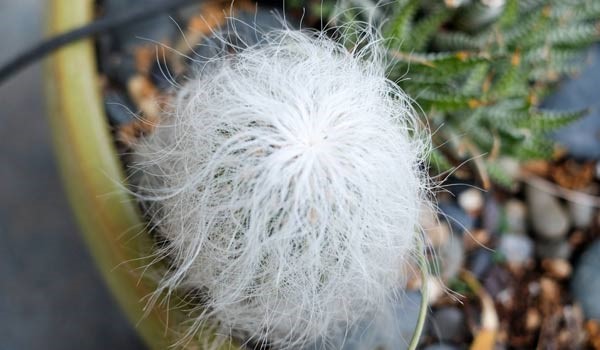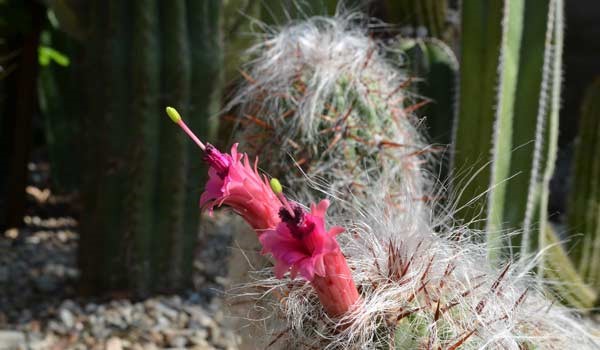Old Man Cactus Care & Grow Tips (Complete Guide)

Resembling an old and shaggy old man, Cephalocereus senilis, aka old man cactus, is sure to bring a lot of character to your succulent collection. Also known as Old Man of the Andes cactus, hairy old man cactus, and Bearded cactus, this odd plant comes from Guanajuato and Hidalgo in Mexico.
Old man cactus has a long and columnar shape and can grow up to 20 feet in the wild. But when you grow its cutting or seed in a container, its size will be limited and suitable for indoors. Since it cannot take the weight of side branches, this cactus usually grows in individual and unbranched stems.
In the following, we’ll tell you everything you need to know about this senior citizen of the succulents’’ world.
Old Man Cactus Bloom & Flower
As its name suggests, the most eye-catching feature of the old man cactus is its coat of long white hairs. When young, these hair are actually shinier and almost silvery white. And as the Cephalocereus senilis becomes older, it starts to lose this signature covering, and all that is left, are yellow spiky spines.
However, the old man cactus flower is another feature that can make you fall in love with this cacti. These night-blooming flowers are red, yellow, or white and fragrant; which later will turn into 1 inch (2.5 cm) fruits. They will emerge from the head of the cacti early in the spring.
You will be blessed by the old man cactus bloom after about 7 years. If you are growing Cephalocereus senilis outdoors, you will not miss the old man cactus bloom. But if you are growing it indoors, you might not be so lucky.

Old Man Cactus Care
You can enjoy growing this lovely plant both indoors and outdoors. Just make sure to keep an eye on its requirements:
Soil
Different types of old man cactus prefer well-draining soil, like pre-made cactus soils or a mixture of sand, perlite, and suitable soil for cacti.
There are many people who also grow old man cactus cutting or seed in natural terra cotta pots. Since these pots let the water evaporate out the sides, and this plant prefers the soil on the dry side, it is another option for caring Cephalocereus senilis.
Water
Before watering your cactus, make sure that the top two inches of its soil are dry. For irrigation in winter, the top couple of inches should be dry. This means that you only need to water it less than two times during winters.
Be very careful and avoid over-watering, as it can make the roots of types of old man cactus rot.
Repotting
Since the old man cactus growth rate is very slow, you will not have to repot it too many times. However, there are times that you need to transplant it.
After a few years, remove the root ball. If the roots has wrapped around the root ball, repot the plant in a container 1/3 or one size lager. When changing the soil (which is essential), you can use the soils that we mentioned in the last part.
Light & Temperature
Light plays an important role in old man cactus care and its growth. So make sure to place it in a spot with as much light as possible, like a South or West-facing window. If can provide such light for your Cephalocereus senilis, its hair will be longer and thicker.
For best growth, when growing indoors, this hairy old man needs a temperature of at least 65 F° (18 C°). In winter and in the hibernation period, its temperature should be 10 to 15 °C (50 to 65°F). It is recommended to encourage this plant to become winter dormant since it helps it survive better.
Because there is less light in winter, and there is not enough light to help your old man cactus grow, your plant may become weak. But when you place it in a colder climate, it simply will not grow to its fullest potential.
Fertilizing
To encourage old man cactus bloom, you can feed the plant in early spring. In general, feed it with a liquid cactus fertilizer every month in spring and summer.
Pests & diseases
Attracting pests is a problem that you might face in old man cactus care. This is because the hairs provide a nice spot for insects like spider mites, mealybugs, and scales to hide in it. So make sure to examine its surface every once in a while, especially if the plant does not seem as lively as always.
Root rot is another common problem that you can easily avoid by watering occasionally. Keep in mind that old man cactus leaning can be a sign of rotting root.
Pruning
Cephalocereus senilis almost needs zero pruning, since it slowly grows in a straight line. And thanks to its dense hairs, it is protected against both heat and cold, while retaining the desired moisture.
What you can do, is an occasional spray of water, combing the hair to clean any dust and insects; and of course, so that your old man looks well-trimmed.

Growing Cephalocereus Senilis
There are two ways to grow this adorable plant, and both are easy: using its seeds or cuttings.
Growing Old Man Cactus Cutting
If you do not have enough time to wait, you can simply plant an old man cactus cutting in a suitable pot with the right soil. But before actually planting the cutting, lie it out on the surface in a dry location for a few f days to callus.
After this time, plant it in dry sand or perlite. Place the cutting in moderate light with at least 70 °F (21 °C) temperature for best rooting. Do not water the old man cactus cutting until it has rooted. After that, care for it like a mature plant.
Growing Cephalocereus Senilis Seeds
Propagating this cactus from the seed is fairly simple, bet requires a lot of patience. You can collect the seeds from an old man cactus flower, or purchase them from a reputable dealer.
The important thing is providing a well-draining soil, and a grow light or a heated seed mat. Growing the seed can also serve as a fun project for children. We recommend doing this in May.
Happy gardening!
- In this post:
- Old Man Cactus Bloom & Flower
- Old Man Cactus Care
- Growing Cephalocereus Senilis



